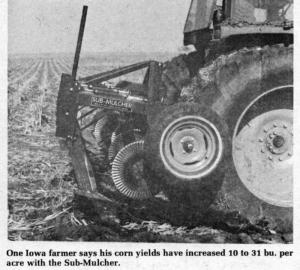1980 - Volume #4, Issue #6, Page #34
[ Sample Stories From This Issue | List of All Stories In This Issue | Print this story
| Read this issue]
Different Type Of Deep Tillage Catching On Fast
 |
"The Sub-Mulcher digs deep with streamlined, self-cleaning shanks that fracture compacted soil up to 20 in. on each side of the shanks without disturbing the soil surface," explains Herbert Brown, president of the Nebraska-based B.C. Company, the manufacturer. Here's how randomly selected Sub-Mulcher owners contacted by FARM SHOW size up the tillage tool:
Raymond Anderson, Clay Center, Neb.: "It's amazing how it can loosen the soil without turning it over," says Raymond, who pulls a five-row Sub-Mulcher with a 100 or more horsepower tractor. "It saves on irrigation fuel. Because Sub-Mulched soil holds more rainfall and snow melt, I can get a good crop of corn with one less irrigation."
James Milsap, Berwyn, Neb.: James says he's still experimenting with different uses for the SubMulcher, but generally uses it after harvest and between rows during the season. "You can work right between rows of growing crops. Doesn't leave the ground with clods, or dry out the soil."
Clayton Schubert, Wilcox, Neb.: "Our corn is all under pivot so I use the Sub-Mulcher when the corn is about 3 ft. tall. I plant six rows and then Sub-Mulch every other row, and water immediately after. I have tested a 5 bu. per acre yield increase and seldom have run-off in the rows that are Sub-Mulched," says Clayton, who bought his 5-row unit three years ago.
Doug Lawrence, Keysport, Ill.: "Our Southern Illinois soils have a shallow top soil with a low organic clay hardpan that restricts permeability of water and air. The Sulr Mulcher has done more than any other tool we've had to loosen up this tight hardpan, something a chisel plow couldn't do. We've used it in the fall and in the spring between rows. It seems to work best in the fall when the ground is dryer and you get good shattering of the clay 'hardpan."
Pat Hogan, Farley, Iowa: "In early summer, when we cultivate with our front-mounted cultivator, we run the Sub-Mulcher on the 3-pt. hitch. Prevents virtually all water runoff. We'll use it after harvest now, too, since the company has added coulters in front of each shoe. This is the only machine I know of that uses this principle and it has a definite place in soil conservation."
Jim McClesky, Dalhart, Texas: "It needs to be built stronger. The machine has worked well when there was enough moisture to keep from shearing bolts, but it isn't built stout enough for extreme conditions which seem to exist in this part of the country. I have bent, worn out or broken almost every piece on Charles Woolridge, Belle Plaine, Kan.: "It loosens the soil deeper than any other deep tillage tool and traps tremendous amounts of rain that would otherwise run off. I'm able to grow better crops in light soils then ever before."
Eldon Worsley, Mendota, Ill.: Eldon pulls a 5-shank model in the fall before plowing. "I get much better drainage on low spots not served by underground drainage," he says. One suggestion he makes is, "to do away with shear pins and spring-load the shanks so they reset automatically."
Bob Tucker, Copeland, Kan.: Bob uses his 15-ft. model to stop wheat ground from blowing and has also used it to renovate existing pasture land. "It greens up pastures and gives a better stand. Has been excellent in all phases of our farming operation, with dryland wheat, irrigated wheat, milo, soybeans and alfalfa."
Larry D. Westphal, State Center, Iowa: "I wish I'd had one 15 years sooner. It provides excellent erosion control and has increased corn yields from 10 to 31 bu. We pull our 5-shank Sub-Mulcher with 95 to 100 horsepower. We also use it for breaking up hardpan surfaces, and for drying up problem wet spots in fields."
Steve Cleavinger, Dalhart, Tex.: "Works great and we won't be without it again if we can help it," reports Steve. He suggests that gauge wheels be added to the 3-shank mode

Click here to download page story appeared in.

Click here to read entire issue
To read the rest of this story, download this issue below or click here to register with your account number.




